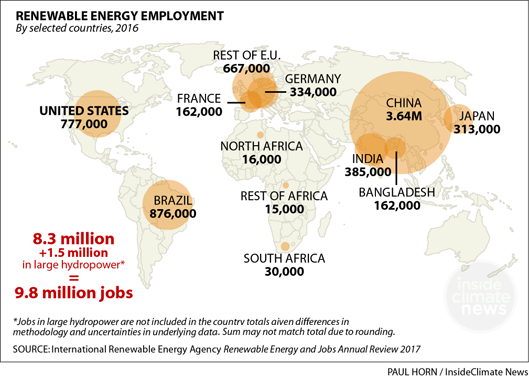U.S. Renewable Energy Jobs Employ 800,000+ People and Rising: in Charts
Twice as many Americans now work in the wind industry as in coal mining, and solar employs many more, but the U.S. still trails the EU and is far behind China.

China leads the world in renewable energy jobs. In the U.S., solar and wind industry employment has skyrocketed in recent years, but now the Trump administration is trying to stop it. Credit: Kevin Grayer/Getty
Renewable energy jobs are growing around the globe as prices fall and interest in clean power rises. Worldwide, 9.8 million people are now employed in the renewable energy industry, including 3 million in the booming photovoltaic solar sector, up 12 percent from just a year ago, a new study shows.
The United States has seen explosive growth in renewable energy jobs over the past three years, led by solar jobs (up 82 percent) and wind jobs (up 100 percent), according to new numbers released by the International Renewable Energy Agency (IRENA).
Each year, IRENA counts employment in renewable energy by technology and country, including in energy generation, related construction, manufacturing of renewable energy equipment and maintenance.
The numbers tell the story.
In 2016, solar was creating U.S. jobs at 17 times the rate of the national economy, rising to more than 260,000 jobs in the U.S. solar industry today. In the U.S. wind industry, now with over 100,000 jobs, a new wind turbine went up every 2.4 hours this past quarter. One driver of this rush to build out solar and wind capacity over the past few years was the expected expiration of key federal tax credits, which were ultimately renewed but with a phase-out over time for wind and solar.
The total number of U.S. renewable energy jobs still falls short of other countries, however.
The U.S. trails the European Union in renewable energy jobs, about 806,000 jobs to over 1.2 million, according to IRENA's numbers. (With hydropower excluded, the totals are 777,000 jobs to 1.16 million in the EU). Brazil also counts more renewable energy jobs, with 876,000, not counting hydropower.
All three are far behind behind China, the world leader in clean energy employment by far with nearly 4 million jobs, including hydropower. China's National Energy Administration has projected renewables growth of 2.6 million jobs a year between 2016 and 2020 with a massive investment plan for renewable power generation.
Meanwhile, the Trump administration is proposing deep cuts to U.S. investment in clean energy innovation in its 2018 budget.

The solar photovoltaics industry leads the world in renewable industry jobs, and biofuels, hydropower and wind energy each employ well over 1 million people worldwide.

Jobs in solar photovoltaics and wind power have grown quickly over the past five years as prices have fallen.
Take the example of Tucson Electric Power. The Arizona utility recently signed a 20-year contract with NextEra Energy to buy solar power at less than 3 cents per kilowatt hour. The utility says the price it's paying for energy from large-scale solar arrays has dropped nearly 75 percent in five years.

How is the U.S. doing?
Jobs in the U.S. wind industry have doubled over the past three years, from around 51,000 at the end of 2013 to over 102,000 at the end of 2016, IRENA data show.
Jobs in solar energy—including photovoltaics, solar heating and concentrated solar power—are up by 117,000 over the past three years, from 143,000 to over 260,000. The increase alone is more than twice the total number of coal mining jobs (51,000) in the United States today.
While renewable energy jobs are on the rise, employment in the coal industry has been falling in many countries. Coal India, the world's largest coal producer, has cut its workforce by 36 percent since 2002. In the EU, coal production has been falling for the past three decades. U.S. coal mining jobs have also been declining over the past 30 years, from 150,000 in 1987 to 51,000 in 2017, according to federal statistics.







